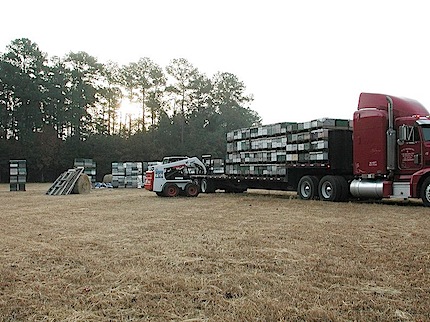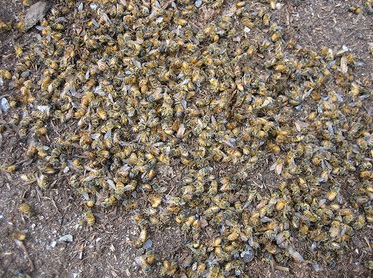You think people would know better by now.
I’ll keep it short, but it’s not sweet. In fact, it breaks my heart to write this.
I’ll also keep it simple for people who might have trouble understanding the facts of life. Yes, I’m talking about the birds and the bees — mostly the bees.
Why Bees are Important to Protect

This Wikipedia photo by Pollinator shows bees being moved from South Carolina to Maine for blueberry pollination.
The production of food throughout the world relies heavily on pollination, much (if not most) of which is accomplished by bees as they gather pollen and nectar from flowers. Bees are so important for agriculture that it’s common for farmers and orchardists to have bees shipped hundreds of miles to their farms — often at a huge expense — to pollenate crops.
is a phenomenon in which worker bees from a beehive or European honey bee colony abruptly disappear. While such disappearances have occurred throughout the history of apiculture, … the syndrome was renamed colony collapse disorder in late 2006 in conjunction with a drastic rise in the number of disappearances of Western honeybee colonies in North America. European beekeepers observed similar phenomena in Belgium, France, the Netherlands, Greece, Italy, Portugal, and Spain, and initial reports have also come in from Switzerland and Germany, albeit to a lesser degree while the Northern Ireland Assembly received reports of a decline greater than 50%.
In other words, the world’s bees are dying.
I can’t stress how screwed the world would be if we lost the bees. I can’t even imagine it.
What Stupid People Do
Last night, when I returned home from a great day out with my dog and friends, I had an email message from someone responding to a Craig’s List ad I posted about wanting bees. He was reporting a swarm in Malaga. He’d sent the message at about 5:30 PM. It was now 8 PM, but still light.
I called him about it. He said the swarm was on a piece of scrap lumber only 2 feet off the ground on a lot with a home under construction. It had been there more than 24 hours. It was easy to reach and probably easy to catch.
Although I sorely wanted to capture the swarm myself, I didn’t want to drive the 40 miles (each way) to Malaga. So I called my friend, Jim, and told him about it. I gave him the address and even looked up directions on Google Maps. It would only take him about 15 minutes to get there. He was psyched. He said he’d throw on his shoes and try to get them.
I heard back from his wife about an hour later.

Dead honey bees.
Jim had found the bees, dead, along with a few cans of Raid.
The bees are dying well enough on their own, but some moron has to go at them with a can of pesticide?
Dozens of beekeepers who live in the area are willing — and eager — to remove a swarm of bees for free, but some idiot has to kill them?
The stupidity of people amazes me.
Don’t Kill the Bees
Please, people, don’t kill the bees.
If you see a swarm, remain calm. Swarming bees are generally not dangerous. They’re just relocating. They’re like you in that big U-Haul truck, parked at a rest stop on the freeway, taking a break.
Call for help.
Your best bet is a beekeeper, if you can find one listed in a local phone book or online for your area. Try Craig’s List; search for “bees” or “swarm.”
The next best bet is the local Humane Society or Animal Control Department of the town or city where you live. They often have contact information for beekeepers.
Next choice: the police, but not 9-1-1. (A bee swarm is not a police emergency.)
Last choice: a pest control company, but with the request that they send someone to remove the bees without killing them. If they won’t do it for free, ask them to find a beekeeper who will. They should have this information handy.
I will concede that if the bees get into the walls of a building or some other place where they can’t be reached, extermination might be necessary. But if you call for help as soon as you see a swarm, you can usually prevent it from getting into that unreachable place and save it.
As the person who contacted me, and my friend Jim tried to do.

 Baked brie is one of my favorite appetizers — and something I like to make for guests when having a dinner or cocktail party. I made it the other night for dinner at a friend’s house; I did all the prep at home and baked it in her oven. It was the second time she’d had it and she asked me to write down the recipe. I thought it would be easiest to just share it here. As you’ll see, it’s very easy.
Baked brie is one of my favorite appetizers — and something I like to make for guests when having a dinner or cocktail party. I made it the other night for dinner at a friend’s house; I did all the prep at home and baked it in her oven. It was the second time she’d had it and she asked me to write down the recipe. I thought it would be easiest to just share it here. As you’ll see, it’s very easy. 1 package Pillsbury Crusty French Loaf (or similar). You should be able to find this in the refrigerator section of your supermarket.
1 package Pillsbury Crusty French Loaf (or similar). You should be able to find this in the refrigerator section of your supermarket.
 I know winter is over, but that doesn’t stop me from making soup. Soup, after all, is comfort food, and we can all use a little comfort now and then — some more than others.
I know winter is over, but that doesn’t stop me from making soup. Soup, after all, is comfort food, and we can all use a little comfort now and then — some more than others.